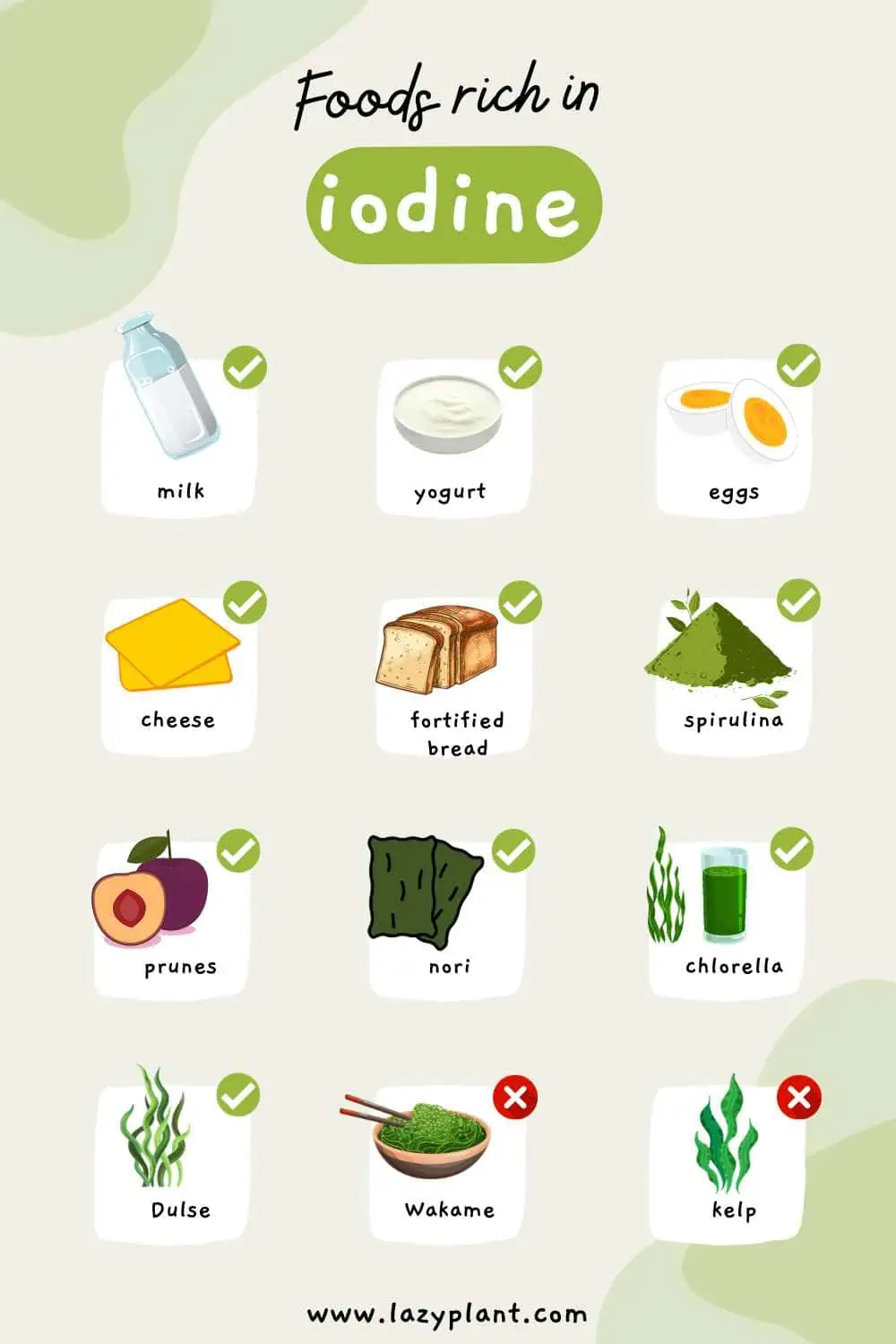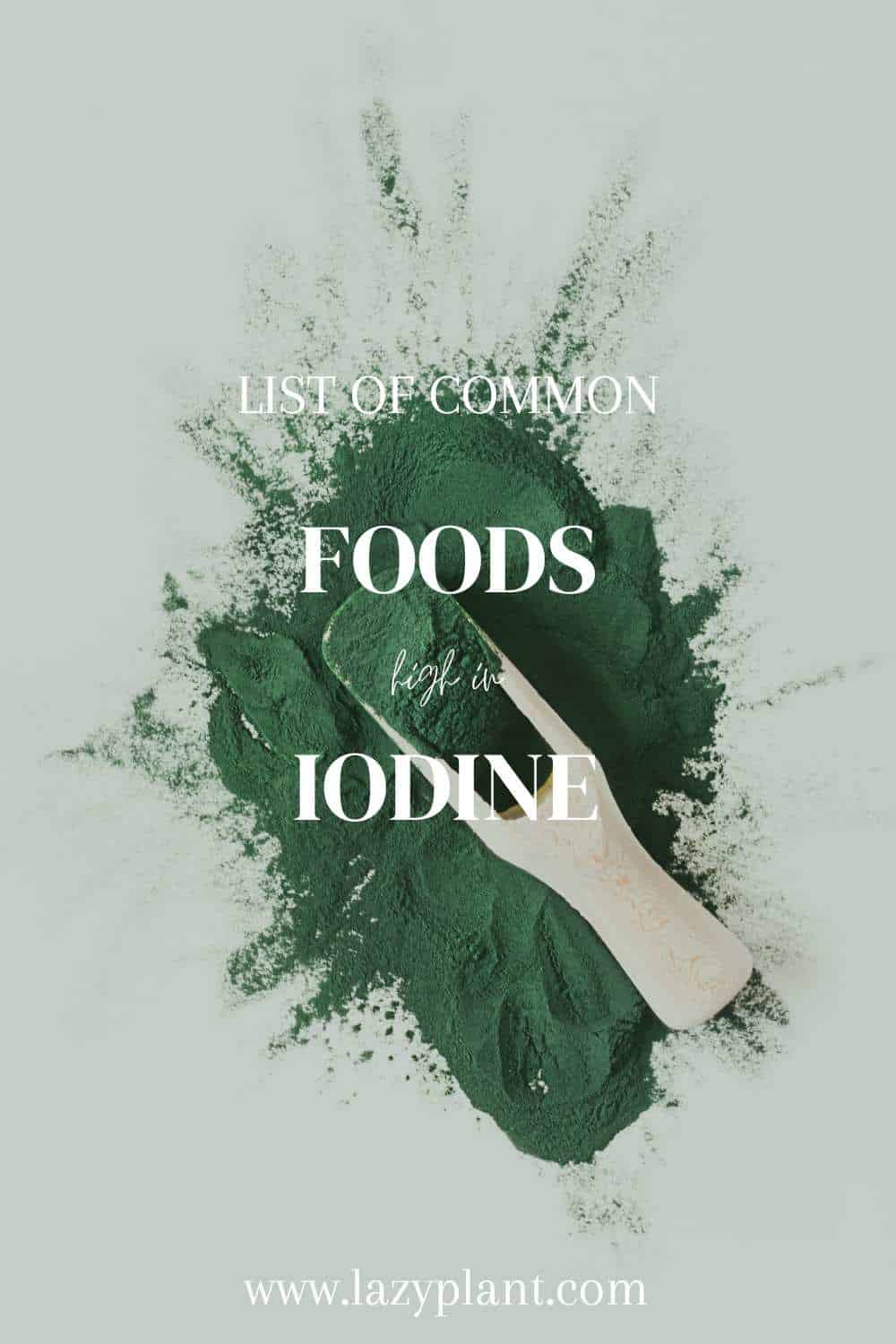Iodine is necessary for various functions of the body. But, consuming too little or too much can be dangerous. Finding the right balance is crucial for your health.
In this article, you’ll find what foods are packed with iodine that you should avoid and what food choices support a balanced iodine status.
Many people consume algae and seaweed to get iodine. But, only spirulina, chlorella, nori and Dulse are safe for regular consumption. Other algae like kelp contain extreme amounts of iodine.
Is iodine important for health?
Iodine is a trace element, which is important for good health. Iodine is a key component for the proper:
- development of the fetus and infant
- secretion of thyroid hormones
- immune response of the body
Moreover, it may help with mammary dysplasia and some breast diseases.
Iodine deficiency may cause:
- impaired mental function
- goiter
- impaired work productivity
- increased risk of thyroid cancer
- increased risk of attention deficit hyperactivity disorder in children
- the abnormal enlargement of the thyroid gland
Only small doses are beneficial, though. Too much iodine can be harmful. In fact, iodine toxicity can cause the same symptoms as iodine deficiency. High doses of iodine can inhibit the synthesis of thyroid hormones.
Thus, consuming certain foods high in iodine, it could lead to iodine toxicity. We should be very cautious with portion sizes of our favorite iodine-rich foods.
How much iodine do we need a day?
Adult men and women require 150 mcg of iodine per day. Teenagers have the same iodine needs as adults.[1,2]
Only pregnant and lactating women require higher dosages. They require 220 and 290 mcg of iodine per day, respectively.

How much iodine is too much?
Adults shouldn’t get more than 1,100 mcg of iodine a day. The maximum safe dosage for teenagers is 900 mcg a day. Children should consume even lower dosages. Only people who receive medical treatment can exceed the maximum safe dose of iodine.
Iodized salt is the main dietary source of iodine
Regular sea salt is rarely fortified with iodine. The amount of iodine in unfortified sea salt depends on the water source. In most cases, it’s pretty small.
Iodized salt is an effective and cheap way to prevent iodine deficiency. About 90% of the American population consumes iodized salt. Just 1/4 tsp of ionized salt provides about 71 mcg of iodine. This dose is 47% of the Daily Value.
Moreover, the pink Himalayan salt usually contains less iodine than iodized salt. In general, Himalayan salt has more minerals and trace elements than table salt. So, if you prefer Himalayan salt, you should consume foods with iodine to prevent iodine deficiency.
Common foods high in iodine
The richest common food in iodine is egg. A large whole egg has about 24.5 mcg of iodine. This dose is 16% of the Daily Value!
Seafood is also a good dietary source of iodine. For instance, cod has 99 mcg, shrimp has 35 mcg, and canned tuna has 17 mcg of iodine per serving.
Dairy products have some iodine as well. A cup of milk provides 56% DV, while a serving of plain Greek yogurt provides 58% of the Daily Value.
Seaweed & algae are rich in iodine
Actually, the richest foods in iodine are certain seaweed and algae. The most common algae and seaweed are kelp, Nori, kombu, wakame, Dulse, spirulina, and chlorella.
We should be very cautious with portion sizes, though. The iodine content of seaweed and algae is very variable. Just 1 gram of seaweed provides between 0 and 2,984 mcg of iodine. That’s 11-1,989% of the DV.
The iodine content of seaweed depends on:
- sea and water region
- variety
- processing method
- storage conditions

Does spirulina have iodine?
Spirulina is a type of blue-green algae, rich in minerals, protein, and chlorophyll.
Most spirulina supplements don’t contain any iodine. However, the amount of iodine in spirulina can vary.
If you want to be 100% sure that spirulina has no iodine, avoid buying spirulina powder in bulk. Prefer packaged spirulina products. Always read the nutrition facts label of spirulina supplements.
Does chlorella have iodine?
Chlorella is a green single-celled algae, which grows in freshwater. Chlorella is nutrient-dense as well. It’s about 50% protein, and it’s packed with minerals, vitamins, and antioxidants.
Chlorella may contain only traces of iodine. In many cases, chlorella contains only about 2 mcg of iodine per gram.[3]
Most chlorella supplements don’t contain any iodine, though.
You can find a wide variety of spirulina and chlorella supplements on iHerb.
Kelp is rich in iodine
On the contrary, kelp is high in iodine. Kelp is algae grown in the sea. The iodine content of kelp is 514-6,571 mcg per gram. Even 1/4 gram of kelp may contain more iodine than the maximum safe dose!
That depends on the pre-harvest conditions. Kelp that has been sun-bleached has less iodine. Fresh kelp has the highest iodine content.[4]
Just to be safe, you could prefer kelp supplements containing only 150 mcg of iodine per tablet. This dose is the recommended daily intake.
Other seaweed & algae rich in iodine
Kombu is an edible kelp, which is particularly rich in iodine. Just 1 gram of kombu contains 1,542 – 5,307 mcg of iodine. You better avoid kombu, as you can easily exceed the maximum safe daily intake of iodine.
Wakame is a type of edible seaweed. It’s part of the traditional Japanese cuisine. Wakame doesn’t contain so much iodine as kombu. It has about 60 – 1,571 mcg of iodine per gram. It may be a good idea to avoid consuming it on a regular basis.
Nori and Dulse are red seaweeds. They have a lower iodine content. Usually, they have less than 100 mcg of iodine per gram.
The iodine content of nori depends on the nori variety and the harvesting region. Nori has about 16 – 43 mcg of iodine per gram. Most people can safely consume nori.
Moreover, nori is the only vegan food rich in taurine; a key amino acid for weight loss.
Dulse is a red, edible seaweed. It grows in wild cold waters. Dulse is a good dietary source of iodine. It contains about 44 – 72 mcg of iodine per gram.

Actually, spirulina and chlorella are algae with the lowest iodine content.
Above all, you should consult your healthcare provider before taking spirulina, chlorella, or any other seaweed or algae supplements. People with thyroid issues should be very cautious with the consumption of iodine-rich foods and supplements.
Other common foods high in iodine
There are many foods containing moderate amounts of iodine:
- Prunes. Just 5 prunes contain 13 mcg of iodine or 9% DV.
- Grains. 1 cup of raisin bran cereal contains 11 mcg of iodine or 7% DV.
- Beans. Just 1/2 cup of lima beans contains 8 mcg of iodine or 5% DV.
- Fruits. 1 cup of apple juice contains 7 mcg of iodine or 5% DV. Also, a banana contains about 3 mcg of iodine or 2% DV.
Fruits, vegetables, and beans are good dietary sources of iodine. But, the iodine content highly depends on:
- the iodine content of the soil
- fertilizer use
- irrigation practices
What foods inhibit the absorption of iodine?
Consuming raw foods that contain goitrogen compounds may lead to iodine deficiency. Goitrogens are substances that inhibit the absorption of iodine in the thyroid. Such foods are cruciferous vegetables. Common cruciferous vegetables are Brussels sprouts, broccoli, cabbage, cauliflower, arugula, bok choy, and collard greens.
Cooking can deactivate goitrogenic compounds, though. So, you should cook your vegetables to increase iodine absorption.